In your aquarium, you can grow either bottom attached plants or floating plants. But if you have scavenging fish in your aquarium it is better to go for floating aquarium plants.
Other than that floating plants will add a unique appearance to your home aquarium. In this article, we are going to talk about 21 floating aquarium plants in detail.
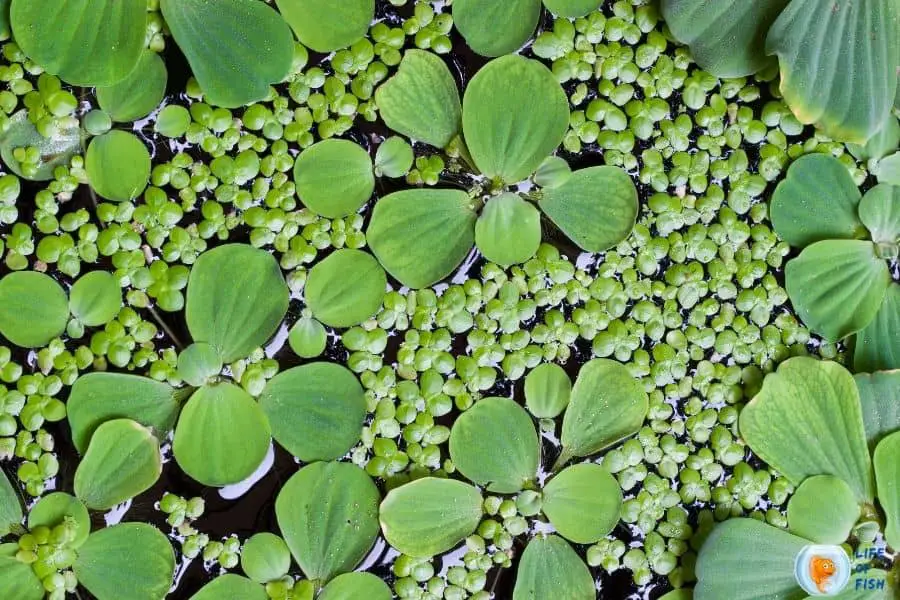
What are floating aquarium plants?
Jump To
- 1 What are floating aquarium plants?
- 2 Best floating aquarium plants
- 3 Benefits of floating aquarium plants
- 4 Are floating plants good for aquariums?
- 5 Do floating plants oxygenate the water?
- 6 How do I keep my aquarium plants floating alive?
- 7 Do floating plants stop algae?
- 8 How do you feed fish with floating plants?
- 9 Do angelfish like floating plants?
- 10 Do floating plants need cO2?
- 11 How do you keep floating plants out of skimmers?
- 12 How do you keep a floating plant in the same place?
- 13 What helps aquatic plants to float in water?
- 14 Conclusion
Floating aquatic plants thrive in freshwater. These plants need freshwater sources to survive, and they emerge from the water. There are three categories of floating aquatic plants.
Free Floating plants – These are plants that float freely on the water surface. Free-floating plants are not attached to anything and are suspended in the water. These plants absorb nutrients directly from the water, and they move around by wind or water currents.
Submersed Floating-Leaved – These plants grow on the bottom of the water source, but their leaves and flowers grow to the water surface and float.
Trailing Floating – These plants grow near shallow areas and have a “trailing” or “creeping” growth habit. They form floating mats over the water surface.
Most floating plants have a very fast growth rate hence are not suitable for natural water sources.
But, some of these plants are popular in the aquarium trade because of their emerging ability and beauty.
Best floating aquarium plants
Below is a list of 21 best floating aquarium plants popular in the aquarium trade.
Amazon Frogbit (Limnobium laevigatum)
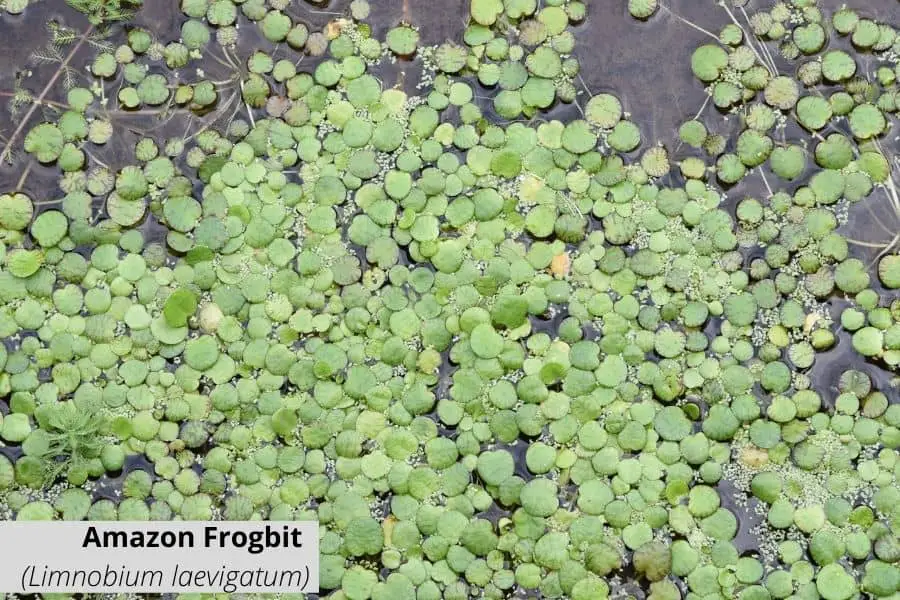
Amazon frogbit is one of the most prevalent floating plants due to its ornamental nature.
These plants have beautiful rounded flat leaves that hover on the water surface, and they are free-floating with long decorative roots.
When the plant matures, it produces spectacular whitish flowers that go beyond the water surface.
It is easy to care for and rapid growing plant, which is more suitable for open aquariums.
Native to south and Central America, Amazon Frogbit is regarded as an invasive species because of its hardy nature and rapid growth rate.
However, many aquarists use this plant in their aquariums without fish as it can deplete oxygen levels.
Anacharis (Genus Elodea)
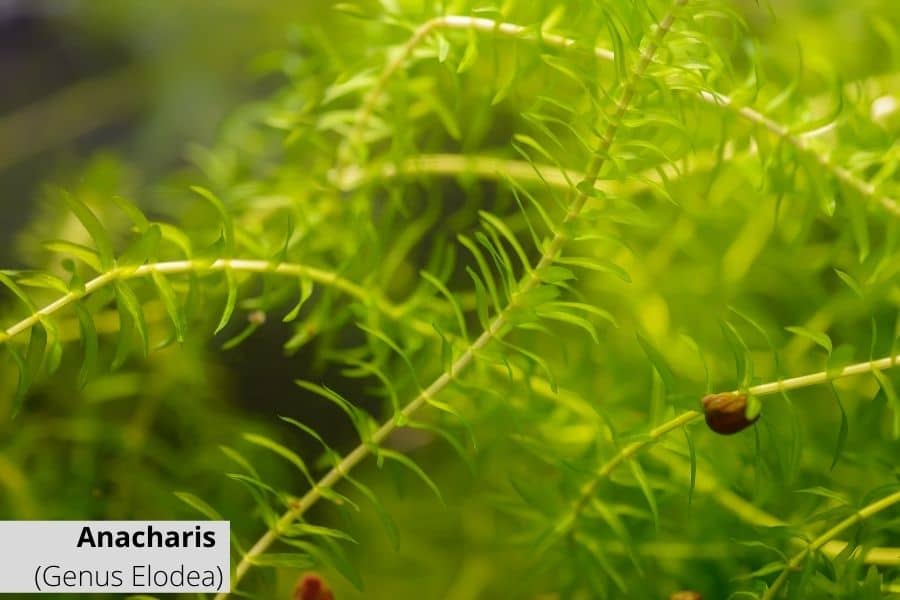
Anacharis is one of the easiest to keep plants in an aquarium as it is highly adaptable and fast-growing.
You can either plant it directly into the substrate or leave it to float. Either way, this plant will thrive, absorbing water nutrients, minimizing algae and bacterial growth.
When the plant matures, it creates a canopy and blooms with beautiful white flowers.
Native to Argentina, Brazil, and Uruguay, Anacharis is more suitable for low-tech community tanks due to its natural filtration ability.
Keeping this plant in an aquarium gives not only a stunning look but also benefits the aquarium.
Baby Tears Giant (Micranthemum Umbrosom)
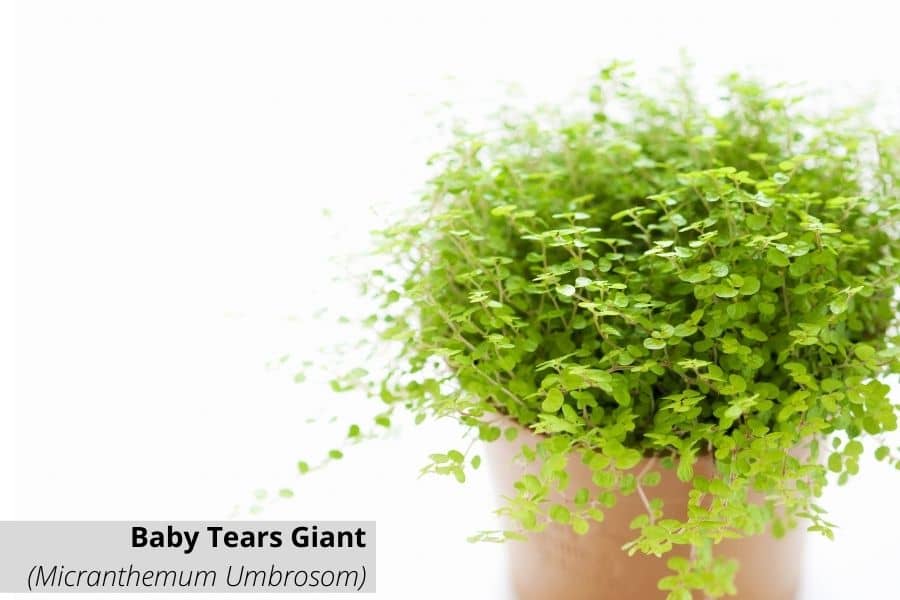
Giant baby tears is a fast-growing versatile stem plant perfect for beginners.
You can use this plant as a foreground, midground, or background plant, and it can grow both horizontally and vertically—the growth rate and the color of this plant change according to the light level you provide.
Giant baby tears is an ideal floating plant for a community fish tank as it absorbs nutrients from fish waste, making the water clean.
Giant baby tears are native to North America. This plant is adaptable to a range of water conditions and does not require CO2 to thrive.
However, it grows best with CO2 injection and moderate light conditions. The plant needs to be pruned constantly to control the overgrowth of this plant.
Brazilian Pennywort (Hydrocotyle leucocephala)
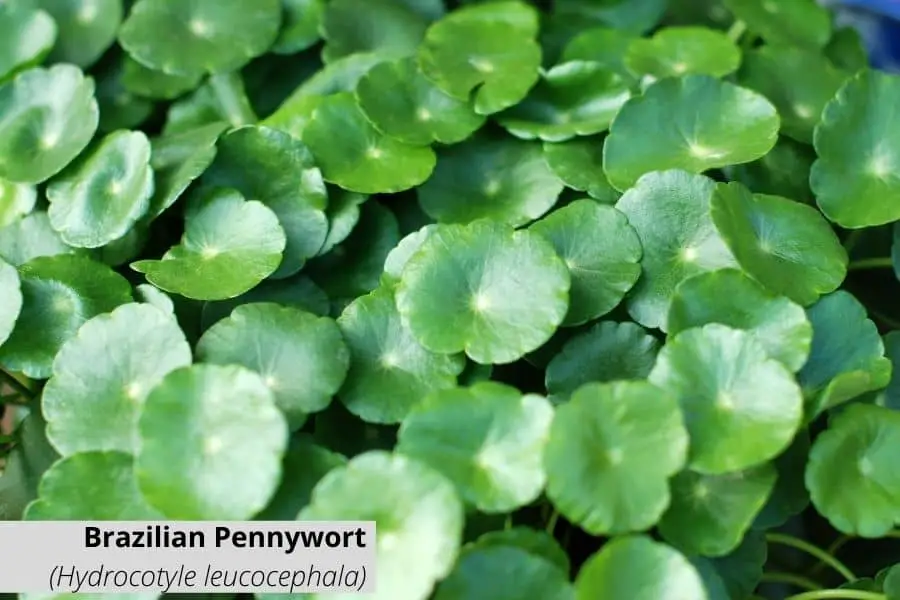
Named after penny-shaped leaves, Brazilian Pennywort is a rapidly growing stem plant popular in the aquarium trade.
At each leaf joint, the stems send out white root shoots. When the Brazilian Pennywort plant reaches the water surface, it blossoms with tiny white flowers.
When this plant emerges from the water, it is aesthetically pleasing, and it will take only a little time to grow and flower.
It is fast-growing and less demanding, which makes it beginner-friendly.
Brazilian pennywort plant is native to South America and Central America but can be found in Argentina and Mexico.
Brazillian Pennywort thrives in many water types and low water conditions. You can plant it on the substrate or let it float on the surface.
Cabomba
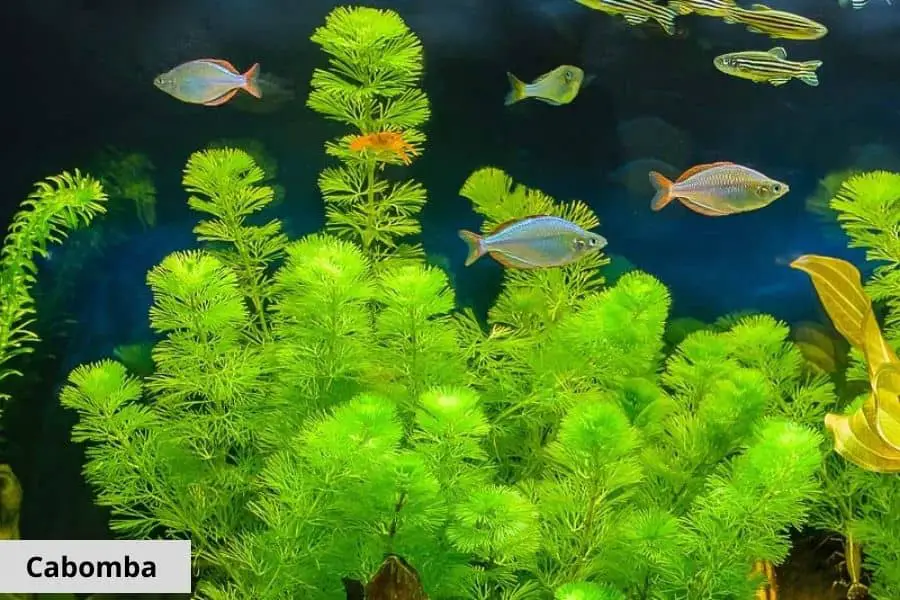
Cabomba, also known as fanwort, is an excellent background plant for hobbyists.
This plant is not so popular like Amazon sword and Java moss but, many stores have this plant under different names.
Cabomba has several color variations; green, purple, and red. Although this is a fully submerged aquatic plant, you can keep this plant as a floating plant.
However, this is not a beginner-friendly aquarium plant.
Native to South America, Cabomba needs specific water and lighting conditions to thrive.
If the plant doesn’t receive these conditions, it tends to die quickly. Cabomba is a delicate plant. So, Cabomba may not be a good choice for a tank with plant-eaters.
Duckweed (family Lemnaceae)
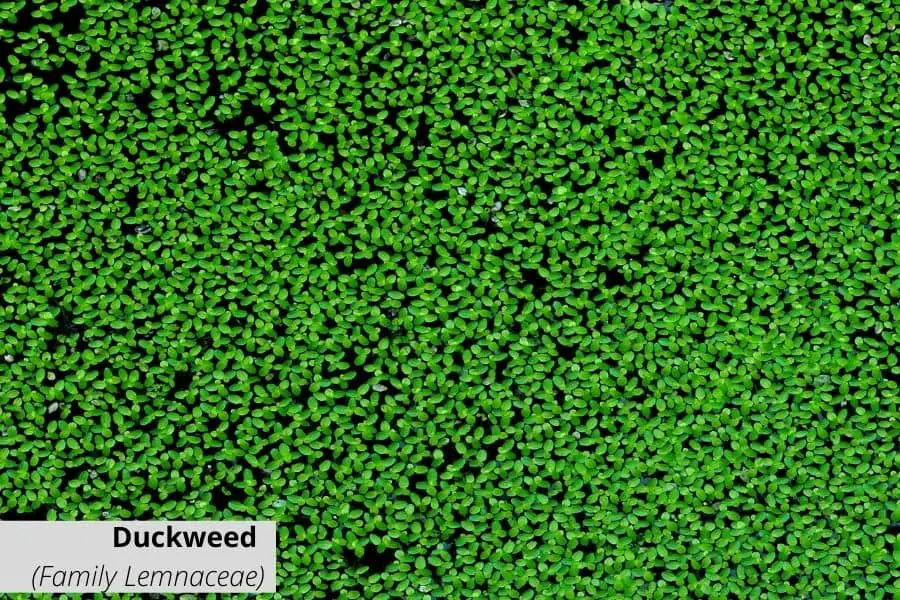
It is a rapidly growing, invasive type, a free-floating plant common in aquariums.
Duckweed is one of the easiest plants to grow in an aquarium and provides many benefits for your fish.
It purifies the water, controls algae growth, serves as a food source, and provides shelter for small fish and invertebrates.
This plant is visually pleasing but, overgrowth may cause oxygen depletion. So, removing some of these plants is needed from time to time.
Since this is an invasive plant species, getting rid of the Duckweed plant is hard once introduced.
Dwarf Water Lettuce (Pistia stratiotes)
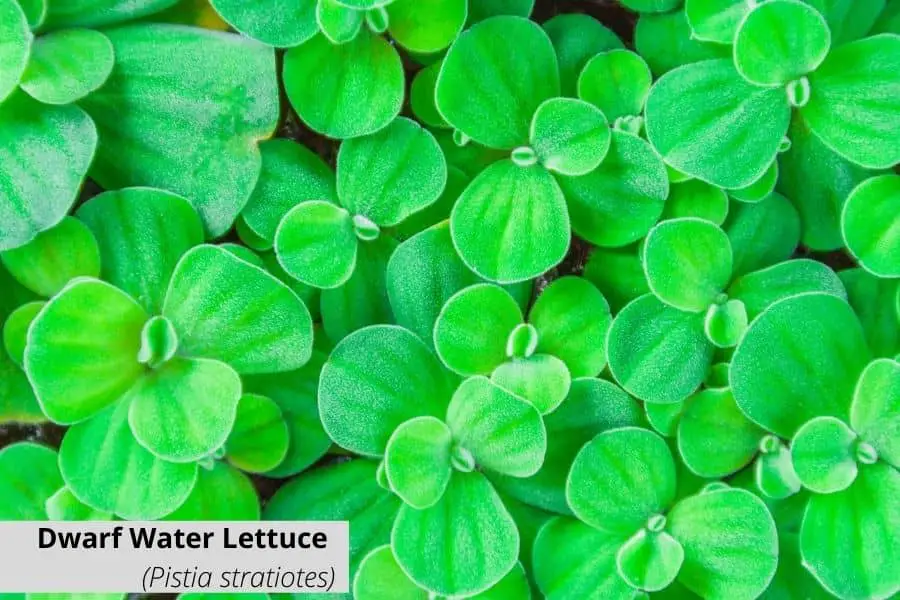
Dwarf water lettuce is a tropical floating aquatic plant that grows pretty much everywhere in the world except for Antarctica.
This plant is an invasive species. Hence this plant is prohibited in many states in the USA. If grown in an aquarium, this plant benefits in many ways.
It provides shelter to mall creatures like newborns, fish fry, and shrimps, serves as a food source, and absorbs harmful nutrients like Ammonia and Nitrate, improving the health of your aquarium.
However, just like other invasive plants, the drawback of this plant is overgrowth will cause oxygen depletion of the tank.
The good news is, you can control the growth of this plant by trimming and maintaining it.
Glossostigma (Glossostigma Elatinoides)
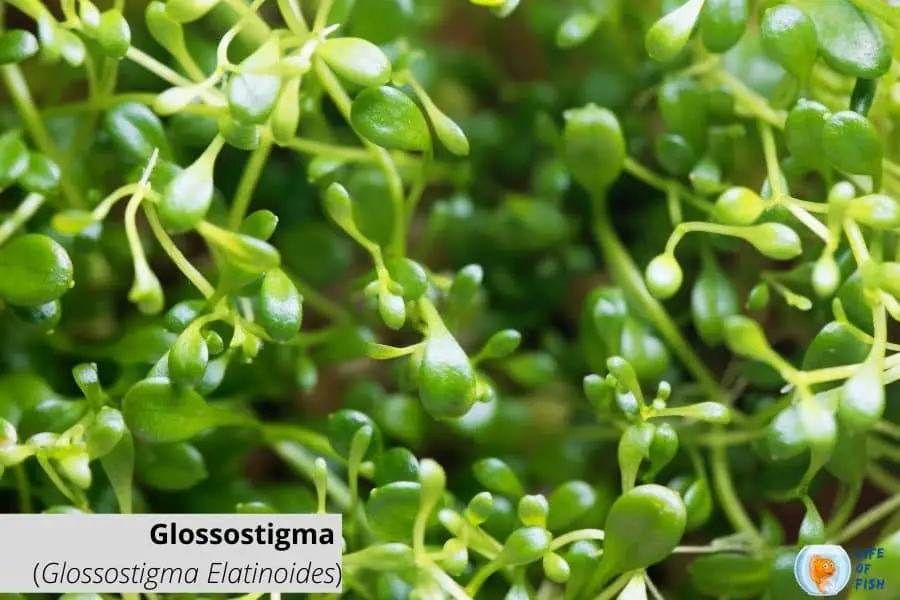
Glossostigma is a demanding plant in Japanese-inspired aquariums because of its aesthetically pleasing appearance.
Native to New Zealand, Glossostigma is one of the smallest aquarium plants that is used as a foreground plant.
However, you can keep this as a floating plant, and the plant will grow horizontal if provided enough light.
Glossostigma is a slow-growing plant and requires a lot of light to thrive. Therefore, it is considered a difficult-to-care-for plant suitable for experienced aquarists.
Hornwort (Ceratophyllum demersum)
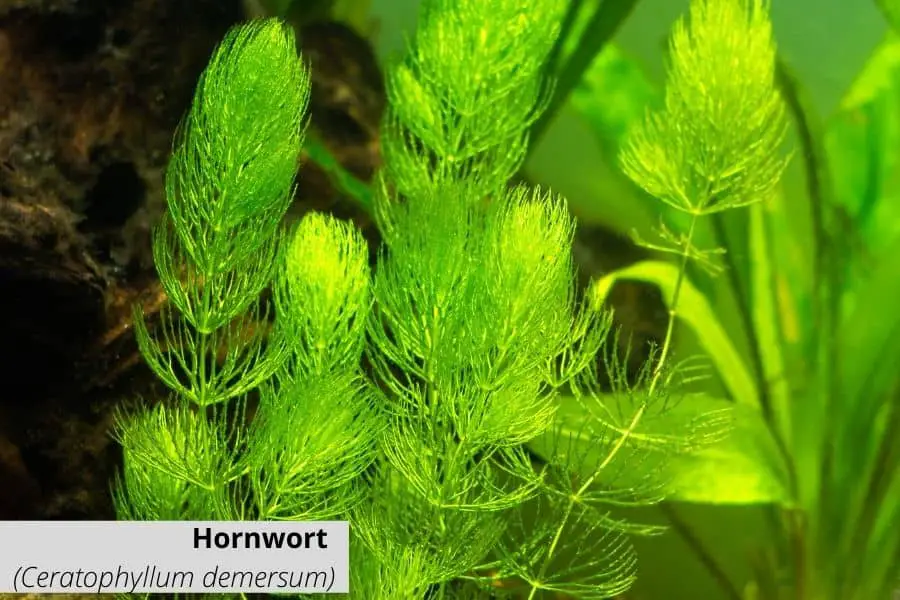
Hornwort is naturally a free-floating plant that can consume excess nutrients from the water.
It is incredibly fast-growing, thus can be a problem sometimes.
Although this is a free-floating plant, you can plant it on the substrate, and it will look like a fluffy underwater bush with long branches or stems.
Hornwort is a suitable plant for community tanks with plant-eating fish like Goldfish, Koi, and Cichlids as its texture and taste are unpleasant for fish as a food.
This plant can thrive on various temperatures and light levels without requiring CO2 injection or fertilizers to grow.
Therefore, it makes an excellent choice for beginner aquarists.
Java Moss (Taxiphyllum barieri)
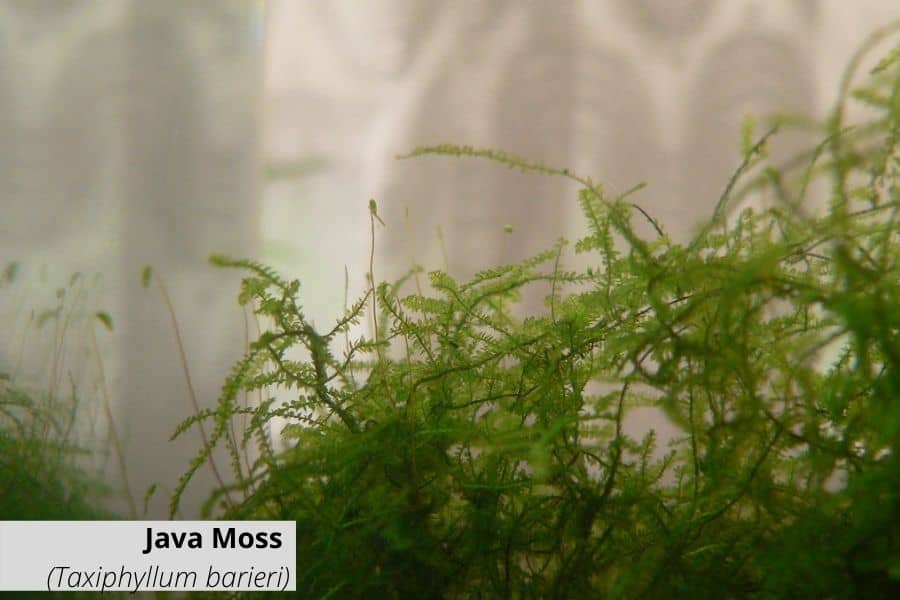
Java moss is not a naturally floating plant, but with some setting up with floating anchors, you can grow this plant emerged from the water surface.
It is one of the most popular aquarium plants due to its aesthetic appearance, hardness, and benefits.
Java moss is an easy-to-grow plant native to Southeast Asia. To float java moss, you have to attach it to a floating anchor like cork bark or Styrofoam.
However, the downside of Java moss is that it attracts algae easily.
creeping primrose-willow (Ludwigia Repens)
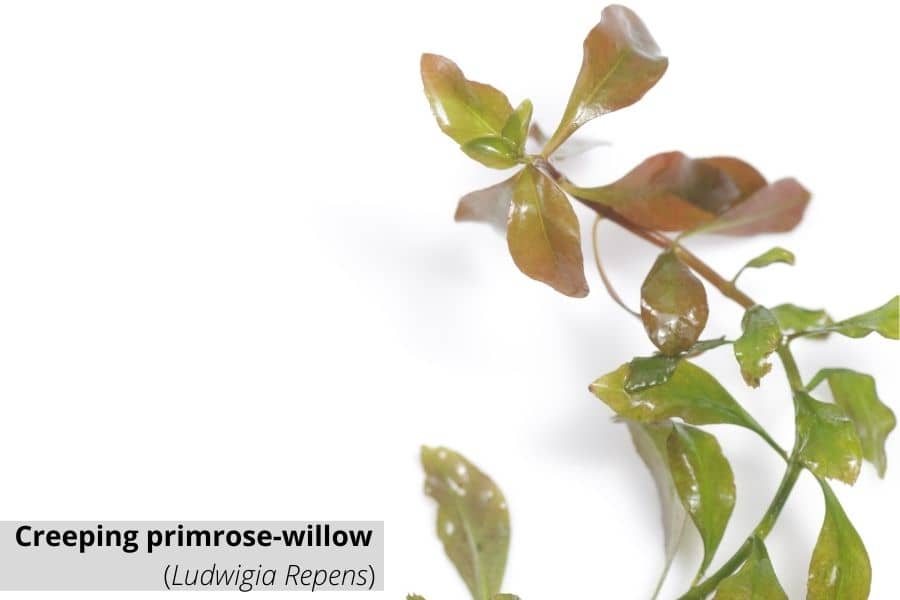
Ludwigia Repens, commonly known as creeping primrose-willow, is a flowering plant in the evening primrose family, native to North America.
It features striking dark red leaves and stalks with small yellow flowers when they emerge. This plant is very decorative when planted in an aquarium, but it has few demands.
To grow efficiently, this plant needs at least a 10-gallon tank and medium-level lights.
Otherwise, the lower leaves of this plant tend to fall off. This plant will grow without further involvement if given required conditions, thus known as an easy to care plant.
Mosquito fern (family Salviniaceae)
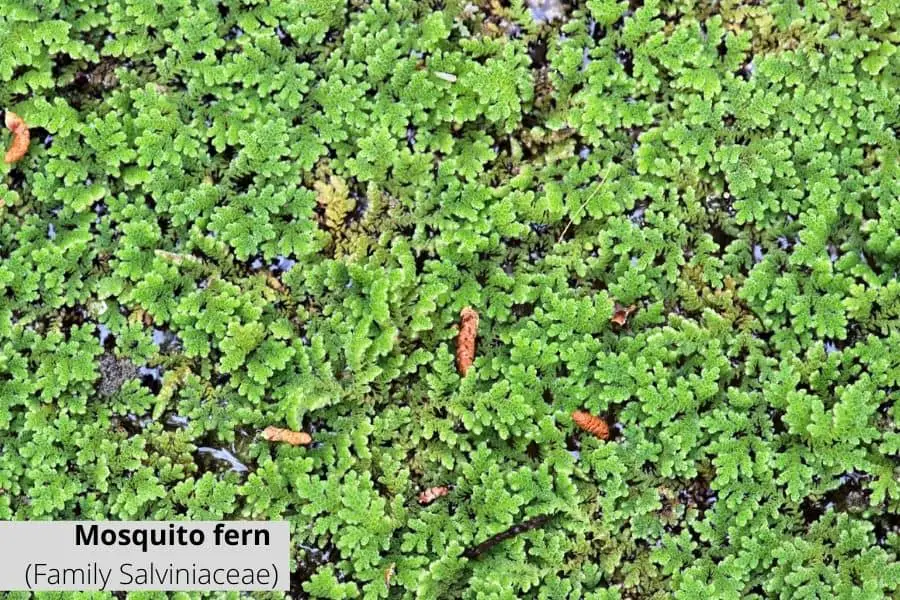
The Mosquito fern is a tiny free-floating fern that forms a thick mat covering the water surface completely.
This plant is considered invasive in its natural water sources because of its rapid growth rate.
It has bright green foliage that turns purplish rose when it gets stresses due to bright lights or temperature fluctuations.
Native to North and South America, Mosquito fern helps keep your aquarium pest and disease-free, serves as food for fish and other aquatic creatures, and provides habitats for many tiny invertebrates.
The Mosquito fern is a gorgeous and beneficial plant for aquariums and ponds if kept under control.
Monte Carlo (Micranthemum sp)
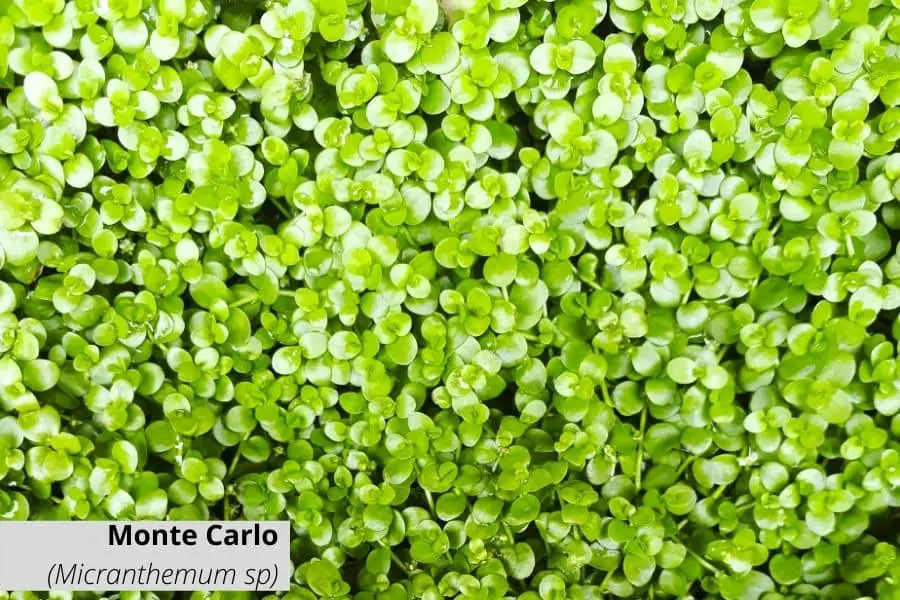
Originates from Argentina, Monte Carlo is a floating aquarium plant with compact, spherical and fresh light green leaves on creeping stalks.
You have to plant Monte Carlo on your aquarium substrate, and it will form a beautiful carpet in the front of the aquarium.
Monte Carlo is fast-growing and easy to care for, but it requires good light conditions and CO2 injections to thrive.
Although this plant is relatively new to the aquarium hobby, it gained popularity so fast because it is a bit more like the world-famous Hemianthus plant, which is harder to grow.
Water Lilly (family Nymphaeaceae)
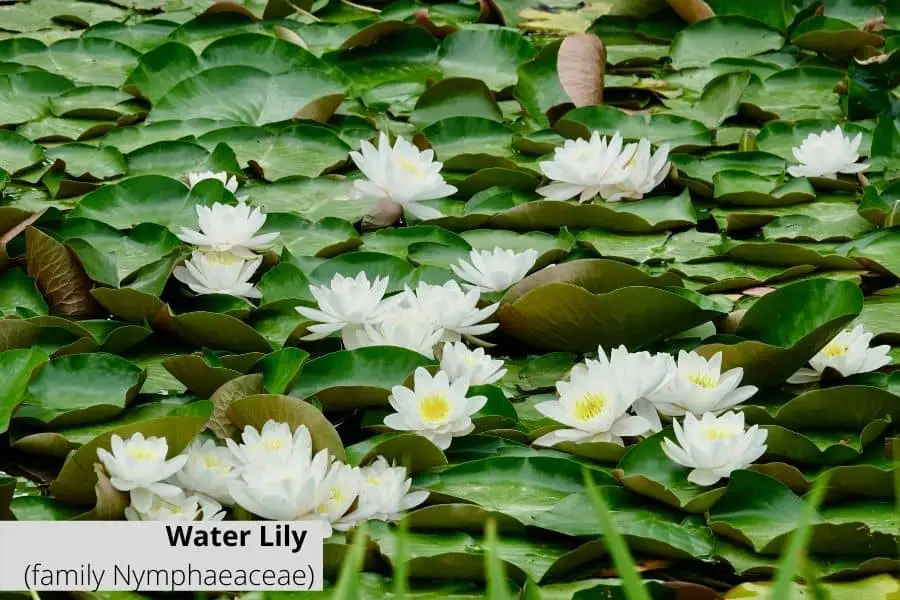
Water lily is a flowering aquarium plant that grows submerged, but leaves and flowers emerge.
There are around 60 water lily species with different colors, shapes, and sizes. This plant is so popular as a pond plant because of its pleasing look and fragrant scent.
However, this plant is a slow-growing plant that needs soil, fertilizers, and light. So, Water lily might not be an ideal choice if you are a beginner aquarist.
Red Root Floater (Phyllanthus fluitans)
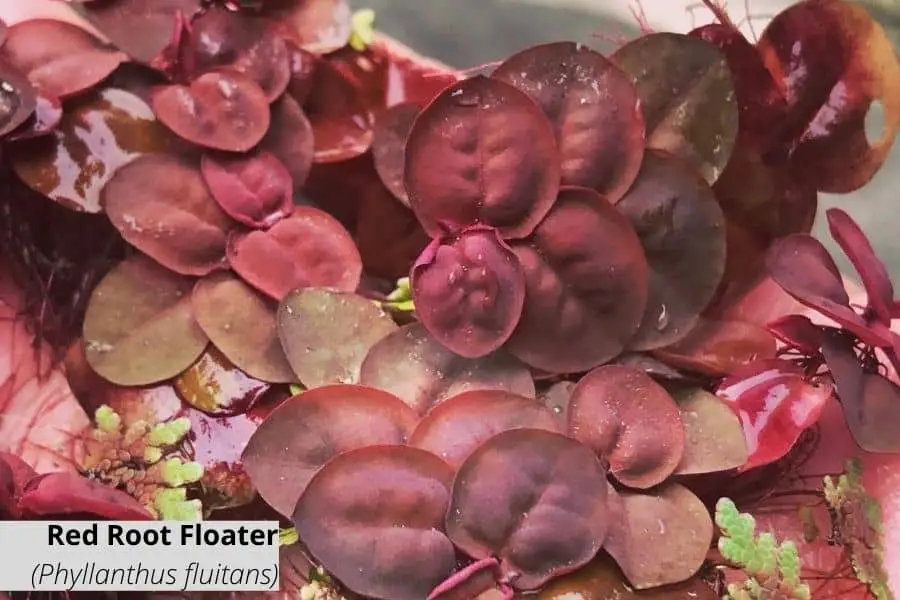
Red root floaters are unique freshwater floating fern that has deep red roots and leaves.
Native to tropical, stagnant water habitats in South America, this is an easy-to-grow plant, even in low-tech aquariums.
Like many other free-floating plants, Redroot floaters are also fast-growing and can cover the entire surface of the tank if left alone for too long.
This may cause oxygen depletion, but you can simply remove some floaters to control the situation.
If maintained well, this plant helps prevents algae growth and helps remove biological waste and other impurities from your tank water. It is a perfect choice for a shrimp tank.
Indian Toothcap (Rotala Indica)
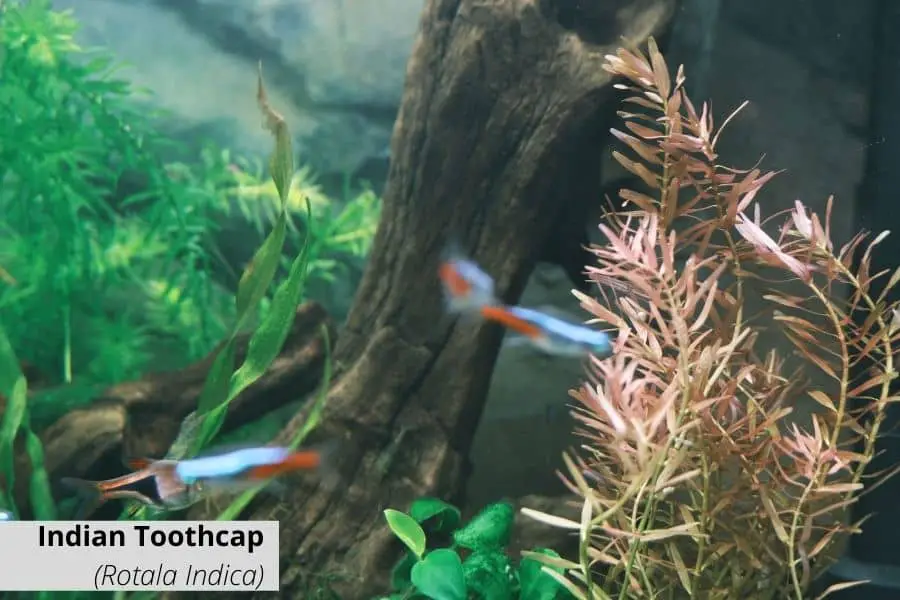
Rotala Indica is a widespread aquarium plant species native to Southeast Asia.
It is a submersed floating-leaved plant that blooms beautiful pink flowers when they emerge.
The top leaves of this plant are green while they turn pink on the lower part. The stems will turn more reddish when the plant receives more CO2 and fertilizers.
You can also propagate this aesthetically pleasing plant into “Bonsai” form to make it look unique. The best part is, it is easy to grow.
giant salvinia (Salvinia auriculata)
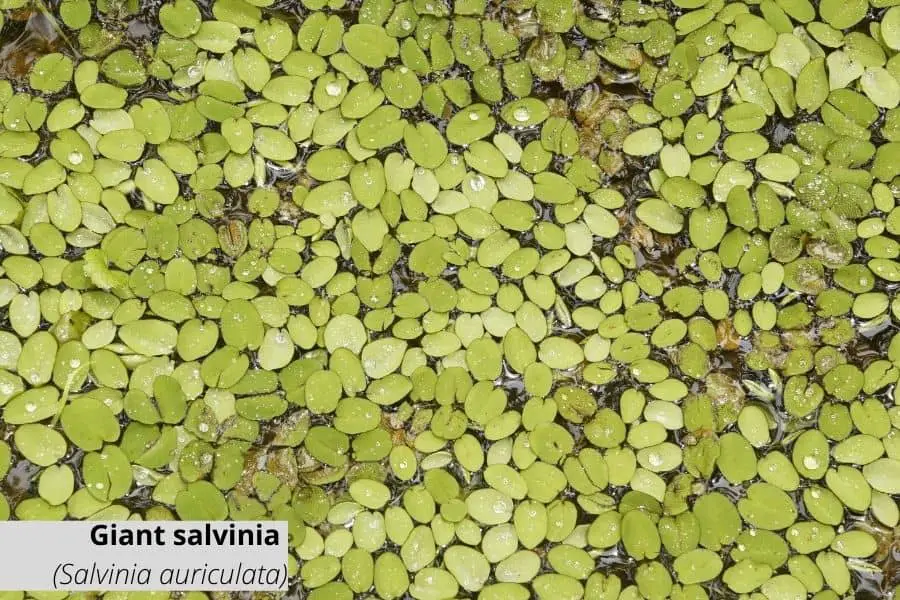
Salvinia auriculata is a free-floating fern popular in the aquarium trade.
Its fast growth rate, decorative look, and hardness make it popular in open aquariums with fish and shrimps.
Salvinia auriculata is a cosmopolitan plant that can be found in many parts of the world.
This plant absorbs abundant nutrients and lights and creates dense green mats on the surface of the water.
Therefore, constant pruning is needed to control the overgrowth of this plant.
If appropriately maintained, Salvinia auriculata can help control the algae growth of the aquarium by absorbing extra nutrients and providing shade.
It also serves as a perfect breeding ground for egg scatterers and dwarf shrimp. And also, fry and young fish can hide in submerged root-like leaves of this plant.
Water hyacinth (Eichhornia crassipes)
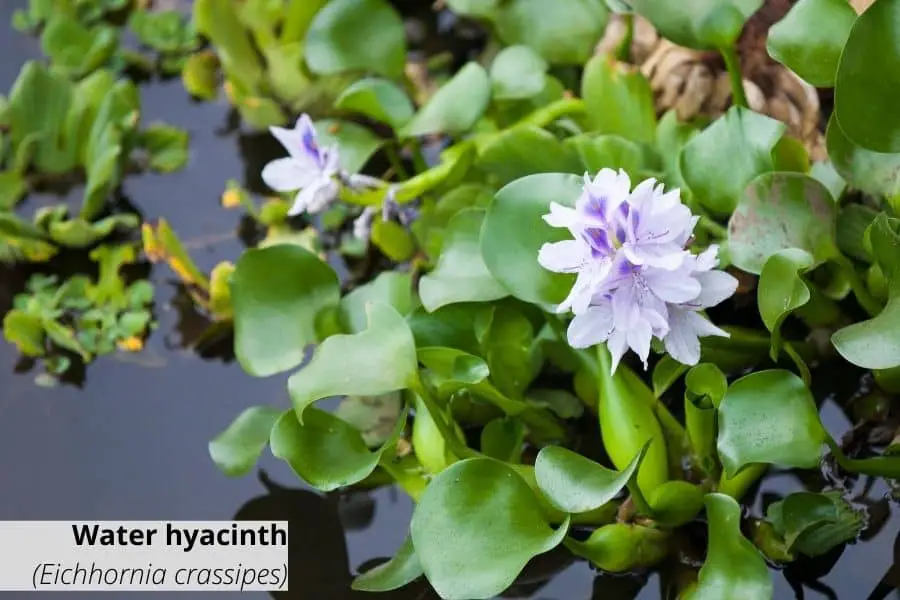
Water hyacinth is a popular floating plant primarily used in ponds.
It features thick glossy leaves and beautiful lavender to pink flowers that grow about 6 inches above the water surface.
Although this is a decorative plant, it can cause problems because this is an invasive species.
Native to South and Central America, Water hyacinth does well in full sun and warm temperatures.
Plant-eating fish and snails appreciate the roots under the plants. These plants also give hiding places for the fish fry.
However, if left alone, these plants can become slightly problematic. However, removing this plant is easy as you just have to remove a batch from your pond/aquarium.
Water Sprite (Ceratopteris thalictroides)

Water sprite is one of the most versatile aquarium plants available in the aquarium trade.
They are also one of the most typical floating aquarium plants available in the local pet stores all the time.
Also known as water fern and Indian fern, this plant originates from slowly moving, calm, or still waters in tropical regions worldwide.
You can keep this plant either planted or floated. It will thrive under low to moderate lighting conditions.
Adding this plant will color up your aquarium with bright green, give shade, and clean the aquarium naturally.
If the plant turns yellow or brown, something is wrong with the plant or the tank conditions.
Water spangles (Salvinia minima)
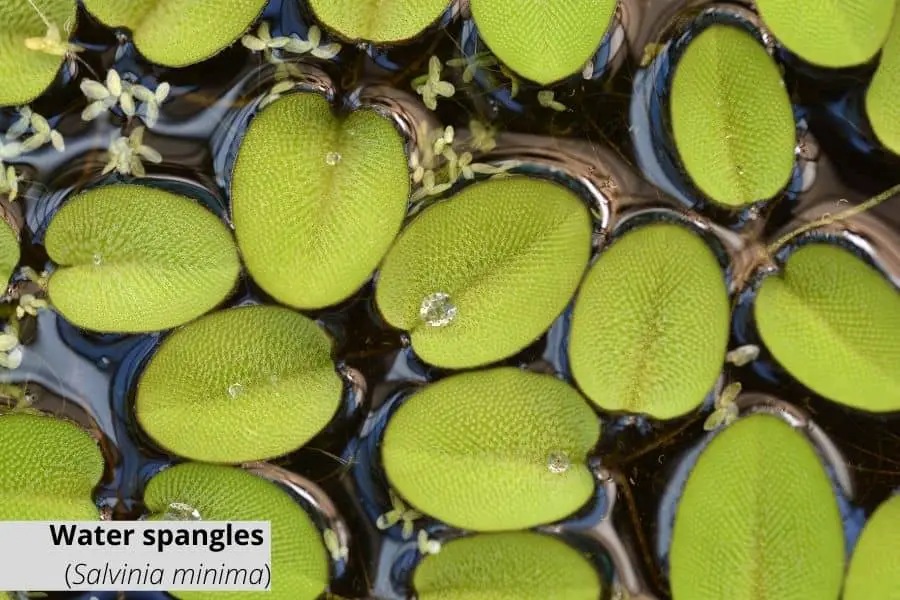
Water spangles are widely available in pet shops worldwide.
Like any other floating plant, these plants are fast-growing, adaptable, hardy, and easy to care for.
In addition, these plants can remove heavy metals, including copper, efficiently. Native to tropical waters of America and Africa, this plant is considered an invasive species and banned in several states.
Water Wisteria (Hydrophila difformis)
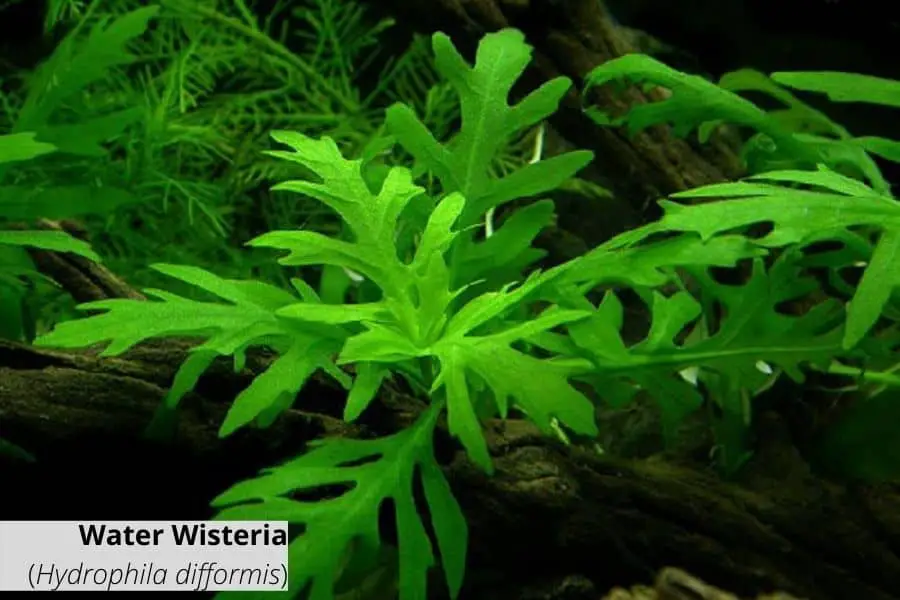
Originate from India, Bangladesh, and Nepal, Water Wisteria is considered a weed because of its fast growth rate.
Water Wisteria is a popular plant for keeping impurities like Ammonia, Nitrite, and Nitrate under control.
They also serve as a shelter for skittish fish and fry, a spawning site for egg scatterers, and food for herbivore fish.
Additionally, this plant can keep cyanobacteria at bay and has anti-microbial properties. Due to its hardy and adaptive nature, this is considered as a set and forget plant.
Benefits of floating aquarium plants
Growing these plants in an aquarium has several benefits.
Although they can be annoying when overgrown, you can simply remove excess plants by merely dragging them.
But, that shouldn’t stop you from growing these plants in your aquarium, as they can help you and your fish a lot.
Cleans Water
They tend to grow fast. These plants grow by absorbing nutrients such as Ammonia, Nitrites, and Nitrates which are toxic to aquatic life.
Although you can control these harmful nutrients with filtration systems, growing floating plants can efficiently remove them than filters, making water clean.
Cover
They also provide shade and cover for small fish species who prefer to stay hidden, like bettas, gourami, and dwarf puffers.
Their dense coverage and long roots act as a safe place for fish fry and shrimps as well.
Having so many hiding spots for these species ensures good health by reducing stress.
Easy to grow and low maintenance
One common fact of floating plants is that they are easy to grow and need low maintenance.
Many aquarists prefer fewer hassles and fast turnarounds when it comes to aquascaping.
Floating plants usually don’t require extra lighting, nutrients, and CO2 to thrive, and they will grow faster than you expect.
Hence, these plants are suitable for open aquariums and low-tech tanks.
Food
Many floating aquarium plants serve as food for many herbivore fish like Goldfish and Koi.
Due to their fast growth rate, your fish will never run out of food, and it will lower the cost of additional fish food from your pocket.
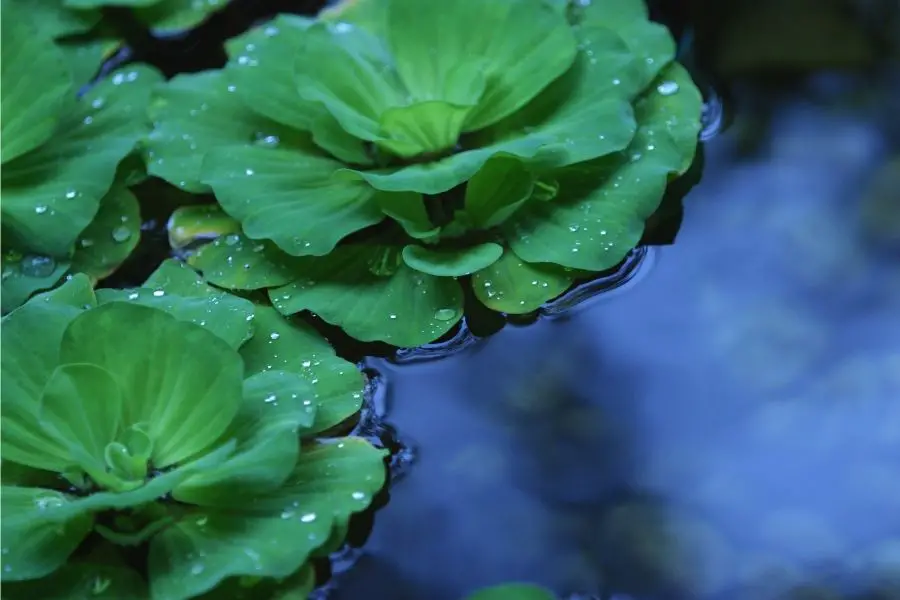
Are floating plants good for aquariums?
Yes. Floating plants are good for aquariums. Growing these plants in your aquarium can benefit you by cleaning the water, providing shelter for small fish and shrimps, and serving as food for herbivore fish.
They do the natural filtration of water, reducing the need for filtration systems, saving you some money.
They also absorb excess nutrients and cover the lightings, which will reduce algae growth in your aquarium.
Although they can be a problem when multiplied, you can simply remove some of these plants to control the situation.
Do floating plants oxygenate the water?
Yes. All or part of floating plants stay beneath the surface, and these parts undergo photosynthesis during the day.
Because of this, these plants absorb CO2 released by your fish and other species and convert them back to Oxygen. This is called oxygenation, and floating plants can do that.
How do I keep my aquarium plants floating alive?
That depends on the aquarium plant type you have. Putting the plant on the water surface will be enough for free-floating plants, and it will continue to grow.
You should attach submersed floating-leaved plants to the substrate, and you should let them grow until they reach the water surface.
Trailing floating plants need some ground area to grow. Usually, aquarists don’t keep trailing floating plants as most aquariums lack ground areas except for ponds.
If you want to float submerged aquarium plants, then you should anchor the plant to a floating anchor such as Styrofoam.
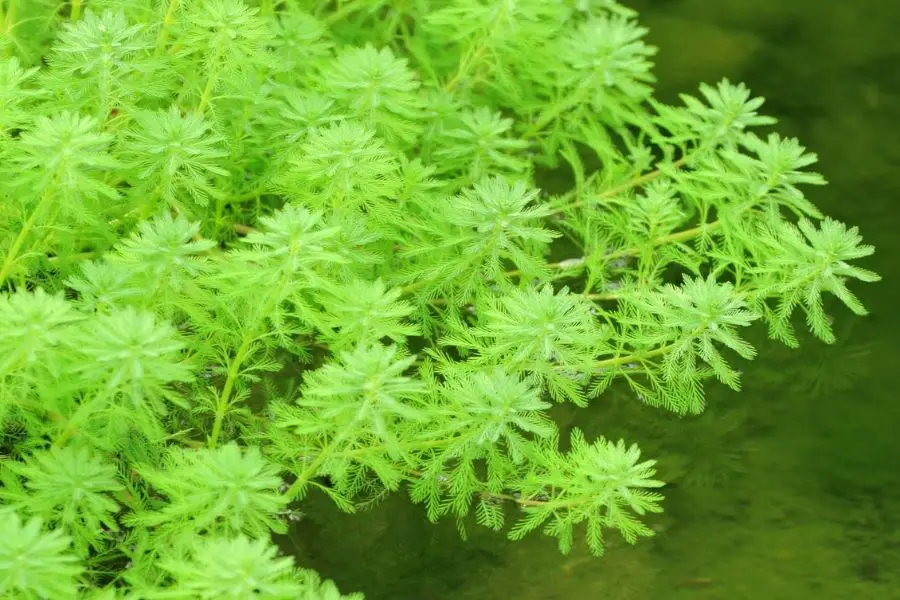
Do floating plants stop algae?
Floating plants help prevent algae by absorbing excess nutrients like Ammonia, Nitrite, and Nitrate and providing shade to the aquarium.
Algae require both light and nutrients to thrive in an aquarium.
Floating aquarium plants cut off these requirements; hence aquariums with floating plants do not usually get affected by algae blooms.
How do you feed fish with floating plants?
One important thing to remember when growing floating aquarium plants is never to let them cover the entire surface of the .aquarium.
Otherwise, the plant will cause oxygen depletion by covering the whole water surface, causing fish to die.
You have to keep a part of the surface clear, and that’s where you should feed your fish.
Do angelfish like floating plants?
Yes. Angelfish like submersed floating-leaved plants as these fish need tall plants with bigger leaves to stick their eggs when breeding.
The fact that floating plants are fast-growing is also beneficial because these fish sometimes get destructive and destroy plants.
So, having plenty of plants will not hurt the aquascape of your aquarium when these fish get destructive.
Do floating plants need cO2?
Many floating plants do not require CO2 to thrive as they absorb naturally released CO2 from the water.
However, if you inject CO2 into these plants, they will grow faster and brighter.
As floating plants have a rapid growth rate, CO2 injection might cause problems when the plant covers the entire aquarium.
How do you keep floating plants out of skimmers?
Floating plants and skimmers do not do well in an aquarium. You have to come across a solution to keep floating plants away from the skimmer unless you want them to get sucked in. There are few tested ways to get this done.
Use a hula hoop
Using a hula hoop, you can keep your floating plants on one side.
Depending on the plant you have, anchor the hula hoop to the bottom or side of the tank and grow your plants over this hula hoop.
Use a floating plant net
Companies like Fosters and Smith make particular nets to keep floating plants organized in an aquarium.
You can use these nets to keep the plants on one side, but be careful using these nets as fish may jump into the net and suffocate.
Use a DIY ring
You can make a DIY ring with a pool noodle and zip ties and use it to keep the floating plants on one side.
Follow the exact instructions of using a hula hoop with the DIY ring.
Can rotala grow floating?
Rotala plants do well when anchored or allowed to float freely in the aquarium. Actually, it does better when float because it gets direct contact with the light source.
Rotala needs strong lighting in order to thrive. So, floating will help this plant jump-start its root system for healthy growth.
How do you keep a floating plant in the same place?
You can either use a hula hoop or a net to keep a floating plant in the same place.
Anchor the net or the hula hoop to the bottom of the aquarium’s side and grow the plant inside it.
However, constant observation is needed if you use netting as fish may jump over the net and may die.
What helps aquatic plants to float in water?
Floating aquatic plants have large air-filled parenchyma cells called aerenchyma that give the plants buoyancy and help them float in the water.
They are present in the stems and roots of these plants.
Conclusion
Growing floating aquarium plants in your aquarium not only give an aesthetic appearance but also benefits your fish.
They can clean the water by absorbing excess nutrients, oxygenating the water, providing fish shelter, preventing annoying algae growth, and serving as food for fish.
However, there are some drawbacks too. Most of these floating aquarium plants are fast-growing.
These plants can completely cover the aquarium in a short amount of time, causing oxygen depletion of water.
But, if you remove excess plants and maintain the aquarium often, you can create a perfect natural habitat with these plants for your fish.
Read Next: Learn To Care Star Moss Like A Professional Aquarist

